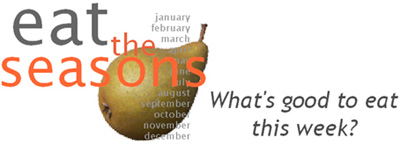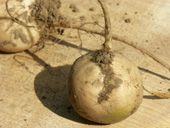
•
UK/Ireland
Canada/USA
________________________________________________________________________

eat
TURNIPS
Turnips come in a variety
of forms, the most widely available being the squashed globe shape with
creamy coloured skin and a purple crown (where the turnip grew above the
surface of the ground and was exposed to sunlight). They have a rounded
flavour - sweet and slightly peppery - and are nutritionally rich.
Although available pretty much year-round we think there are two optimum times for turnip eating. The first is in early summer when fresh, tender, baby turnips are available. The second is towards the end of the year when the more mature specimens make a tasty, healthy and economical contribution to a warming winter diet.
HISTORY
Turnips are thought to have originated in N. Europe around 2,000 BC and were one of the first vegetables to have been cultivated. They were a very important food for the Romans and a staple across Europe before the potato.
Turnips seem to have something of an image problem in Britain, perhaps as a result of them being grown primarily for cattle fodder in the nineteenth century. Other nationalities view this vegetable much more positively and have put it to many imaginative uses. The French braise or sauté them, and serve glazed turnips with duck; Italians use them in risottos; the Chinese have long enjoyed sweet roasted turnip and in Japan and the Middle East many forms of pickled turnips are very popular.
BIOLOGY
The turnip (Brassica rapa) is a cruciferous vegetable (a member of the mustard family) that thrives in cool climates.
NUTRITION
Turnips are rich in vitamin C, phosphorus and fibre. They also contain vitamin B6, calcium, manganese, potassium and indoles - compounds that helps the body generate a number of beneficial enzymes.
TIPS
BUYING
Turnips should be firm and heavy for their size (indicating a good moisture
content) with a smooth undamaged surface. Smaller turnips are sweeter
and more tender. Young turnips are sometimes sold with their leaves attached,
in which case they should be crisp and green (and are excellent when rinsed
and briefly steamed).
STORING
Remove the leaves (if present) and keep in the fridge, or other cool,
dry place. Baby turnips should be used within 2 or 3 days, larger winter
turnips will keep for a week or so.
PREPARING
Wash and trim before use. Baby turnips can be used whole (they're good
grated raw in salads), larger ones should be peeled.
To bake, cut into slices or cubes and place in a baking dish with a sprinkling of water. Cover and bake at around 200°C until tender (30 to 45 minutes). Larger chunks can be roasted like potatoes alongside meat or poultry and can also be boiled or steamed. The flavour intensifies during cooking so avoid cooking for too long or the taste can be a bit overpowering.
OTHER STUFF
Get a copy of Ten More Turnips From the Tip, the final album from an in-form Ian Dury & The Blockheads.
PICK OF THE RECIPES
in
season:
january
february
march
april
may
june
july
august
september
october
november
december
Central London
locale
Pastry, pasta,
puds and lots more!
Fun and deliciously
different
www.cookeryschool.co.uk

A
contract catering
company that puts
quality and freshness first
www.artizian.co.uk
ONLINE
IN PRINT
-
Turnips the Friulian Way
Antonio Carluccio's Vegetables -
Roast Partridge with Soft Chestnut Sauerkraut and Cranberry Turnips
The Complete Cookery Year -
Canard aux Navets
Elizabeth David Classics
© 2004-2010 eat the seasons | contact @ eattheseasons.co.uk | about

